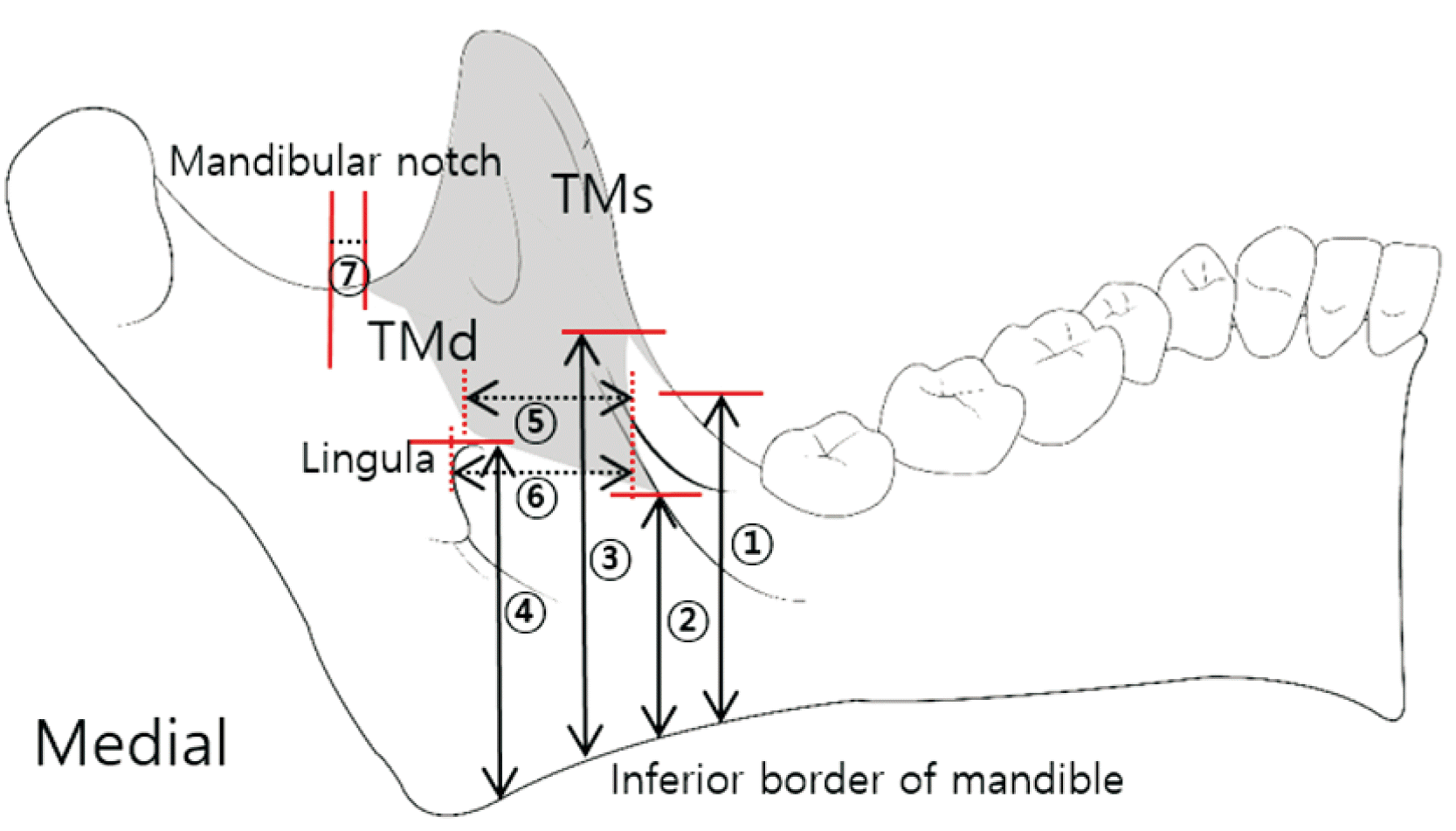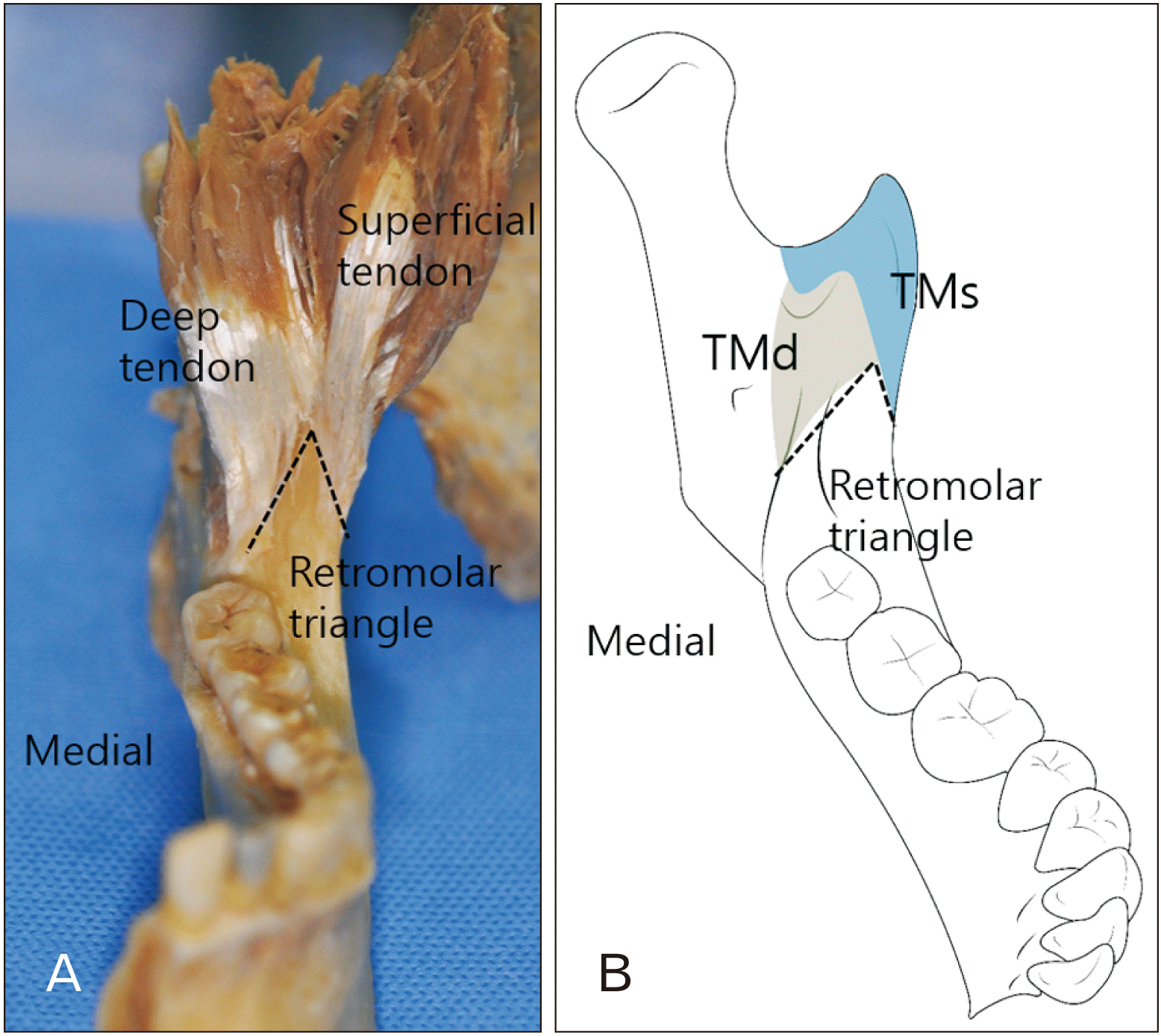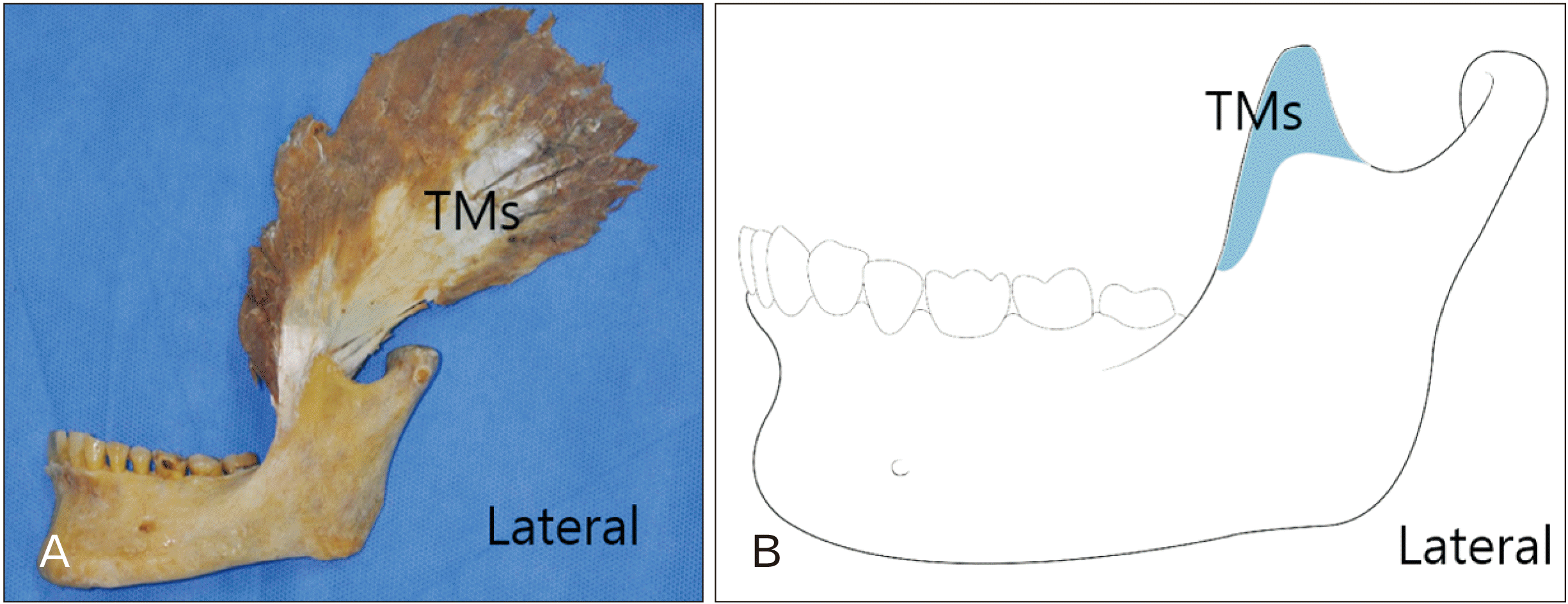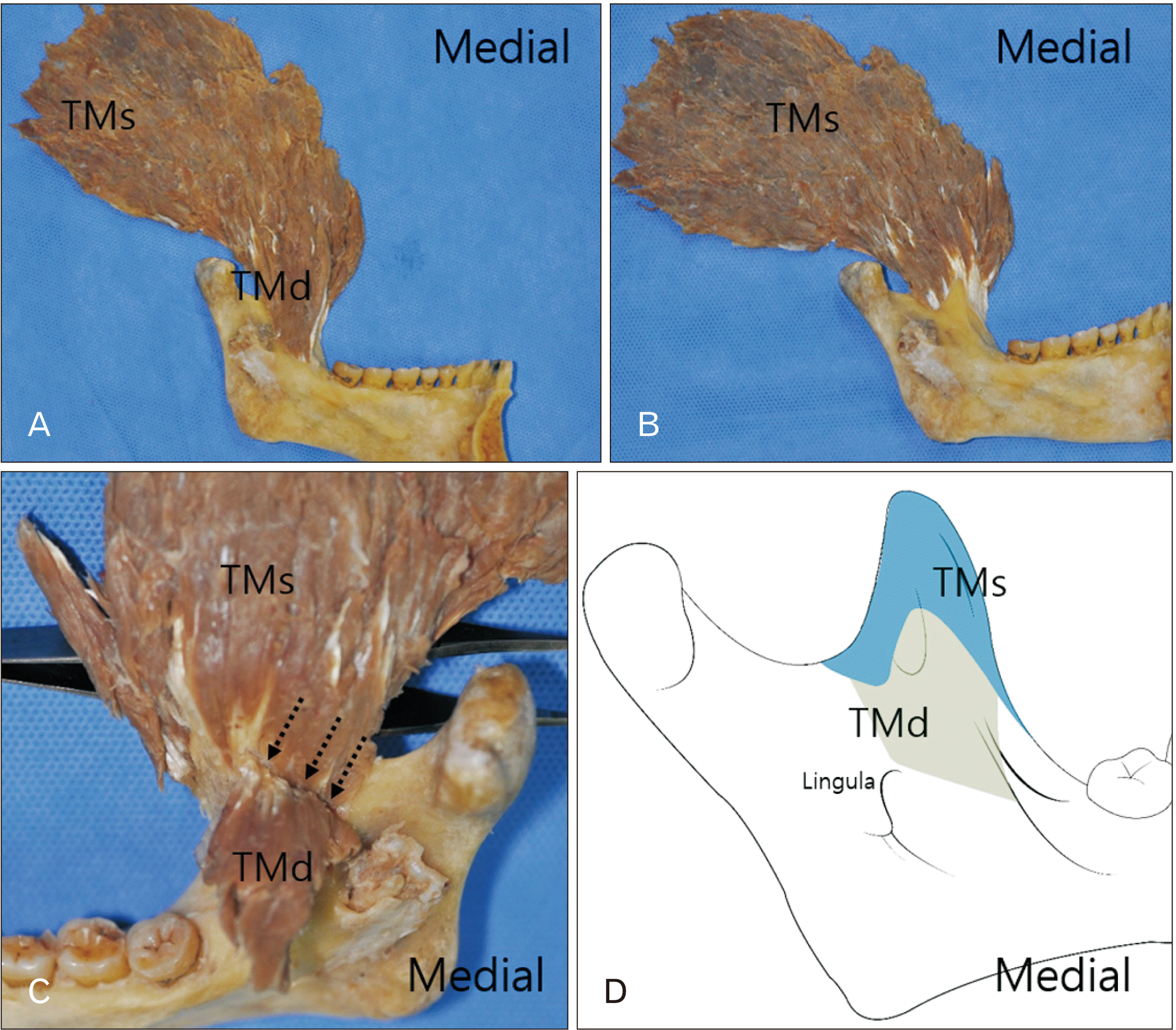1. Geers C, Nyssen-Behets C, Cosnard G, Lengelé B. 2005; The deep belly of the temporalis muscle: an anatomical, histological and MRI study. Surg Radiol Anat. 27:184–91. DOI:
10.1007/s00276-004-0306-3. PMID:
15821860.

3. Sedlmayr JC, Kirsch CF, Wisco JJ. 2009; The human temporalis muscle: superficial, deep, and zygomatic parts comprise one structural unit. Clin Anat. 22:655–64. DOI:
10.1002/ca.20837. PMID:
19637294.

4. Lee JY, Kim JN, Kim SH, Choi HG, Hu KS, Kim HJ, Song WC, Koh KS. 2012; Anatomical verification and designation of the superficial layer of the temporalis muscle. Clin Anat. 25:176–81. DOI:
10.1002/ca.21212. PMID:
21739477.

5. Drake RL, Vogl W, Mitchell AWM, Gray H. 2010. Gray's anatomy for students. 2nd ed. Churchill Livingstone;Philadelphia:
6. Schuenke M, Schulte E, Schumacher U. 2010. Thieme atlas of anatomy. Thieme Stuttgart;New York:
7. Benninger B, Lee BI. 2012; Clinical importance of morphology and nomenclature of distal attachment of temporalis tendon. J Oral Maxillofac Surg. 70:557–61. DOI:
10.1016/j.joms.2011.02.047. PMID:
21549487.

8. Harn SD, Shackelford LS. 1982; Further evaluation of the superficial and deep tendons of the human temporalis muscle. Anat Rec. 202:537–48. DOI:
10.1002/ar.1092020413. PMID:
7072995.

9. Bressler HB, Friedman T, Friedman L. 2017; Ultrasound-guided injection of the temporalis tendon: a novel technique. J Ultrasound Med. 36:2125–31. DOI:
10.1002/jum.14232. PMID:
28504311.

10. Owusu Boahene KD. 2016; Temporalis muscle tendon unit transfer for smile restoration after facial paralysis. Facial Plast Surg Clin North Am. 24:37–45. DOI:
10.1016/j.fsc.2015.09.004. PMID:
26611700.

11. Palomari ET, Picosse LR, Tobo MP, Isayama RN, da Cunha MR. 2013; Sphenomandibular muscle or deep bundle of temporal muscle? Int J Morphol. 31:1158–61. DOI:
10.4067/S0717-95022013000400002.

12. Parker NP, Eisler LS, Dresner HS, Walsh WE. 2012; Orthodromic temporalis tendon transfer: anatomical considerations. Arch Facial Plast Surg. 14:39–44. DOI:
10.1001/archfaci.2011.1277. PMID:
22250268.
13. Kim MK. 2017. Head and neck anatomy. 6th ed. Dental & Medical Publishing;Seoul:
14. Gaudy JF, Zouaoui A, Bravetti P, Charrier JL, Laison F. 2001; Functional anatomy of the human temporal muscle. Surg Radiol Anat. 23:389–98. DOI:
10.1007/s00276-001-0389-z. PMID:
11963621.

15. Won SY, Kim DH, Yang HM, Park JT, Kwak HH, Hu KS, Kim HJ. 2011; Clinical and anatomical approach using Sihler's staining technique (whole mount nerve stain). Anat Cell Biol. 44:1–7. DOI:
10.5115/acb.2011.44.1.1. PMID:
21519543. PMCID:
PMC3080003.

16. Blanksma NG, van Eijden TM. 1995; Electromyographic heterogeneity in the human temporalis and masseter muscles during static biting, open/close excursions, and chewing. J Dent Res. 74:1318–27. DOI:
10.1177/00220345950740061201. PMID:
7629340.
17. Mérida-Velasco JR, Rodríguez-Vázquez JF, De La Cuadra C, Mérida-Velasco JA, Jiménez-Collado J. 2001; The course of the buccal nerve: relationships with the temporalis muscle during the prenatal period. J Anat. 198(Pt 4):423–9. DOI:
10.1017/S0021878201007567. PMID:
11327204. PMCID:
PMC1468228.
18. Logan BM, Hutchings RT, Reynolds PA, McMinn RMH. 2004. McMinn's Colour atlas of head & neck anatomy. Mosby;London:
19. Akita K, Sakaguchi-Kuma T, Fukino K, Ono T. 2019; Masticatory muscles and branches of mandibular nerve: positional relationships between various muscle bundles and their innervating branches. Anat Rec (Hoboken). 302:609–19. DOI:
10.1002/ar.23943. PMID:
30312011.

20. Eisler P. von Bardeleben K, editor. 1912. Die Muskeln des stammes. Handbuch der anatomie des menschen. Gustav Fischer;Jena: p. 197–220. German.
21. Yoshikawa T, Suzuki T. 1962; The lamination of the human masseter- the new identification of M. temporalis superficialis, M. maxillomandibularis and M. zygomaticomandibularis in the human anatomy. Acta Anat Nippon. 37:260–7.
22. Zenker W. 1954; Function of the medial portion of the M. temporalis. Osterr Z Stomatol. 51:550–4. German. PMID:
14356656.
23. Tomo S. 1990; Morphological classification of the mastication muscle based on their innervation. Ochanomizu Med J Tokyo. 38:57–71. Japanese.
24. Shankland WE 2nd, Negulesco JA, O'Brian B. 1996; The "pre-anterior belly" of the temporalis muscle: a preliminary study of a newly described muscle. Cranio. 14:106–12. DOI:
10.1080/08869634.1996.11745956. PMID:
8949865.

25. Dunn GF, Hack GD, Robinson WL, Koritzer RT. 1996; Anatomical observation of a craniomandibular muscle originating from the skull base: the sphenomandibularis. Cranio. 14:97–103. DOI:
10.1080/08869634.1996.11745955. PMID:
8949864.

26. Kim HJ, Park BS, Cho YH, Yu SK. 2017; Course of buccal nerve on the anterior border of mandibular ramus related to temporalis tendon. Oral Biol Res. 41:236–9. DOI:
10.21851/obr.41.04.201712.236.

27. Ranganathan K, Terjimanian M, Lisiecki J, Rinkinen J, Mukkamala A, Brownley C, Buchman SR, Wang SC, Levi B. 2014; Temporalis muscle morphomics: the psoas of the craniofacial skeleton. J Surg Res. 186:246–52. DOI:
10.1016/j.jss.2013.07.059. PMID:
24079810.

28. Shimokawa T, Akita K, Soma K, Sato T. 1999; An anatomical study of the muscles innervated by the masseteric nerve. Okajimas Folia Anat Jpn. 75:271–80. DOI:
10.2535/ofaj1936.75.6_271. PMID:
10217945.

29. Khoury JN, Mihailidis S, Ghabriel M, Townsend G. 2011; Applied anatomy of the pterygomandibular space: improving the success of inferior alveolar nerve blocks. Aust Dent J. 56:112–21. DOI:
10.1111/j.1834-7819.2011.01312.x. PMID:
21623801.









 PDF
PDF Citation
Citation Print
Print



 XML Download
XML Download